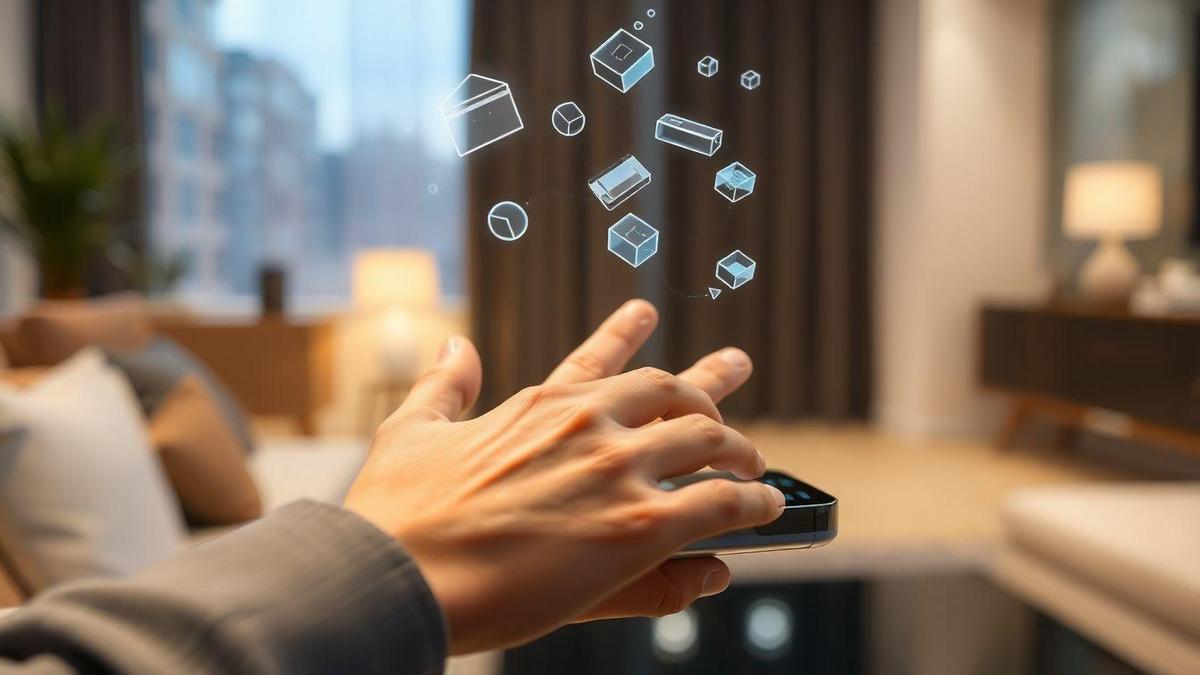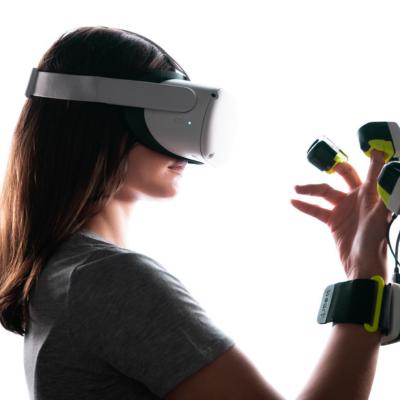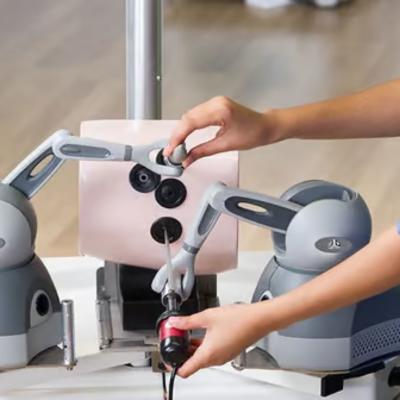Anúncios
Haptic technology has been transforming the way we interact with digital environments. By allowing us to feel virtual objects, these devices bring the physical world closer to the virtual one. This fusion provides a richer and more immersive experience for users.
By combining sensors, actuators, and algorithms, haptic devices simulate textures, resistance, and weight. Their application ranges from entertainment to professional training. Digital touch is no longer a futuristic idea but a present reality.
Anúncios

What Are Haptic Devices
Haptic devices are technologies that allow us to physically feel the digital world. Through vibrations, pressures, and movements, they simulate touch on virtual objects. This makes them essential for making digital experiences more realistic.
The word “haptic” comes from the Greek “haptikos,” which means “related to touch.” These devices transform digital signals into physical stimuli perceived by the body. This way, the user feels as if they are interacting with real objects.
They work through sensors that capture the user’s movements in real-time. Based on this, actuators generate physical responses that mimic different sensations. Everything is coordinated by algorithms to ensure precision and fluidity.
These sensations include texture, shape, resistance, and even temperature. In this way, the virtual experience becomes more natural and engaging. This significantly expands the potential for applications across various fields.
How Haptic Devices Allow Touch on Virtual Objects Work
Haptic devices are innovative tools designed to simulate the sensation of touch in virtual environments. They achieve this through a combination of advanced technologies, including actuators, sensors, and software algorithms. The primary function of these devices is to provide tactile feedback, allowing users to interact with virtual objects as if they were real. This technology relies on principles of physics and human perception to create realistic sensations, such as texture, weight, and resistance.
The core of haptic technology lies in its ability to translate digital interactions into physical sensations. When a user interacts with a virtual object, the haptic device detects the user’s movements and applies corresponding forces to mimic the sensation of touch. For example, if a user is holding a virtual object, the device may simulate the weight and texture of the object by applying pressure to the user’s hand. This feedback loop between the user and the device is crucial to creating an immersive experience.
Moreover, haptic devices use various types of actuators to generate different sensations. These actuators can produce vibrations, forces, or movements that correspond to the properties of the virtual object. For instance, a user might feel a smooth surface when touching a virtual button or a rough texture when interacting with a virtual rock. The accuracy and responsiveness of these actuators greatly enhance the realism of the virtual experience, making it more engaging and intuitive.
In addition to actuators, haptic devices employ sensors that track the user’s movements and interactions in real-time. These sensors can detect the position, speed, and force exerted by the user, allowing the device to adjust its feedback dynamically. This adaptability is essential for creating a smooth interaction between the user and the virtual environment, ensuring that the sensations experienced are consistent with the user’s actions.
Practical Applications of Haptic Technology

In medicine, haptic devices are used in surgical simulators. They help doctors practice techniques safely before operating on real patients. This reduces risks and improves the quality of training.
In engineering, they allow testing of designs with tactile virtual prototypes. Engineers can feel the fit and operation of parts before manufacturing. This saves time and reduces development costs.
In education, they expand accessibility for students with visual impairments. Digital content can be felt through tactile stimuli. This democratizes access to information and learning.
In entertainment, haptic devices create immersive experiences in games and movies. Players feel impacts, textures, and movements in real-time. This elevates the level of emotional and physical engagement.
Advantages of Haptic Devices That Allow Touch on Virtual Objects
The advantages of haptic devices in virtual environments are numerous and impactful. One of the most significant benefits is the enhancement of the user experience. By providing tactile feedback, haptic devices create a more immersive environment that engages users on a deeper level. This sense of touch adds a layer of realism that visual and auditory stimuli alone cannot achieve, making interactions feel more natural and intuitive.
Another advantage is the improvement in training and simulation applications. Haptic devices are increasingly being used in fields such as medicine, aviation, and engineering, where realistic simulations are crucial for effective training. For example, surgeons can practice delicate procedures using haptic feedback to simulate the resistance and texture of human tissue. This hands-on experience is invaluable for developing skills and confidence in real-world scenarios.
Additionally, haptic technology can enhance accessibility for individuals with disabilities. By providing tactile feedback, these devices can help users with visual impairments interact with digital content more effectively. For instance, haptic devices can translate visual information into tactile sensations, allowing users to navigate virtual environments and access information that would otherwise be difficult to perceive.
Furthermore, haptic devices have the potential to revolutionize gaming and entertainment. The gaming industry has already begun incorporating haptic technology to create more engaging and immersive experiences. Players can feel the impact of explosions, the recoil of weapons, or the texture of surfaces, all contributing to a more captivating gaming experience. This integration of haptic feedback can lead to greater player satisfaction and engagement.
How to Integrate Haptic Devices into Projects
The integration begins with selecting the right haptic device. It is important to consider the type of application and the level of feedback desired. Devices range from simple motors to complex robotic systems.
Next, the device must be connected to the virtual environment. To do this, specific SDKs and APIs are used to facilitate this communication. The software needs to interpret and transmit the tactile stimuli correctly.
Interaction design is a crucial step in this process. The experience must be intuitive and usable, with a focus on tactile response. This ensures that the feedback not only works but also makes sense.
Finally, user testing is essential for adjustments and improvements. User feedback allows for calibrating the intensity, duration, and type of stimulus. This results in a smoother and more convincing experience.
Challenges and Future Perspectives
Despite the advancements, there are still technical and economic challenges to overcome. High-quality haptic devices are often expensive and complex. This limits their widespread adoption in certain sectors.
Another obstacle is the development of more refined tactile feedback. Simulating textures and physical properties accurately is still difficult. Research continues to advance to improve these sensations.
However, the prospects are extremely promising. It is expected that miniaturization and the use of AI will make devices more accessible. As a result, they could be widely used in education, healthcare, and entertainment.
The future points to increasing integration between the senses. Virtual environments could involve touch, sight, hearing, and even smell. The digital experience will become almost indistinguishable from physical reality.
How to Use Haptic Devices That Allow Touch on Virtual Objects

Using haptic devices to enhance interactions with virtual objects involves several key steps. First, it is essential to select the right haptic device that meets your specific needs and applications. There are various types of haptic devices available, ranging from simple vibration motors to advanced robotic arms. Understanding the capabilities and limitations of each device is crucial for effective implementation.
Next, integrating the haptic device with the virtual environment is vital. This process typically involves using software development kits (SDKs) or application programming interfaces (APIs) that facilitate communication between the haptic device and the virtual platform. Developers must ensure that the device’s feedback mechanisms are properly calibrated to match the properties of the virtual objects, such as weight, texture, and resistance.
Once the device is integrated, designing the user experience is the next step. This involves creating interactions that leverage the haptic device’s feedback capabilities. For example, developers may design scenarios where users must manipulate virtual objects in a way that feels natural and intuitive. This could include incorporating different levels of resistance, simulating varied textures, or providing feedback based on user actions.
Finally, testing and refining haptic interactions is crucial to achieving optimal performance. User testing can provide valuable insights into how haptic feedback improves the experience. Developers should gather feedback from users to identify areas for improvement and make necessary adjustments to the haptic response. Continuous iteration and refinement will lead to a more polished and engaging experience for users.
Choosing the Right Device: Research and select a haptic device that aligns with the goals and requirements of your project.
Integration with Software: Use SDKs or APIs to connect the haptic device with your virtual environment for seamless interaction.
User Interaction Design: Create intuitive and engaging scenarios that utilize haptic feedback to enhance the user experience.
Testing and Iteration: Conduct user testing to gather feedback and refine haptic interactions for optimal performance.
Exploring Applications: Consider various applications for haptic technology, such as training simulations, games, or accessibility tools.
Stay Updated: Keep an eye on innovations in haptic technology and software to continually improve your projects.
In conclusion, effectively using haptic devices requires careful consideration of device selection, integration, design, and testing. By following these steps, developers can create immersive experiences that harness the power of touch in virtual environments.
Did You Enjoy Learning About Haptic Devices That Allow Touch on Virtual Objects?
Learning about haptic devices and their role in enabling touch on virtual objects opens up a fascinating world of possibilities. As technology continues to evolve, the potential to create immersive and interactive experiences grows exponentially. The integration of touch into virtual environments not only enhances user engagement but also paves the way for innovative applications across various fields.
If you’re intrigued by the capabilities of haptic technology, there’s much more to explore. From innovations in device design to new applications in training, gaming, and accessibility, the future of haptic devices promises exciting developments that could transform the way we interact with digital content. Stay curious and continue exploring this captivating field!
Frequently Asked Questions
What are haptic devices?
Haptic devices are tools that allow you to feel the touch on virtual objects. They use vibrations and forces to simulate the sensation of touching something.
How do haptic devices improve virtual reality?
These devices enhance your virtual reality experience by making it more realistic. You can feel textures and shapes, making everything more engaging.
What types of haptic devices are there?
There are several options, such as gloves, controllers, and even vibrating chairs. Each offers different ways to feel the touch on virtual objects.
Are haptic devices that allow touch on virtual objects expensive?
Prices vary widely. Some devices are affordable, while others that are more advanced may cost more. It’s worth researching!
Where can I use haptic devices?
You can use these devices in games, simulations, and even education. They help you learn and have fun at the same time!
